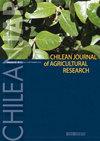桃树和李树核心种质的表型和遗传分析
IF 1.7
4区 农林科学
Q2 Agricultural and Biological Sciences
引用次数: 0
摘要
了解果树种质资源中表型和遗传变量之间的关系有助于进行育种前期和品种区分。在两个生长季节,对23个桃/油桃(Prunus persica(L.)Batsch)和16个日本李(Pruns salicina Lindl.var.saricina)品种的核心集合分别进行了33个和29个特征(植物学/生产性)的评估。此外,还分析了这两个物种中的8个特异性简单序列重复(SSR)标记。主成分分析显示,23个桃/油桃品种的7个特征(与果实大小和果肉硬度有关)是最重要的,16个日本李品种的4个特征(产量、果实大小、可溶性固形物和收获时间)是最主要的。这些分析表明,三个品种的桃子(钻石公主、迪克森和戴维斯博士)和三个油桃(红宝石钻石、北极甜、夏火)的果实大小和果肉硬度值最高。四个日本李品种(Angeleno、Flavor Rich、Red Heart和Pink Delight)在产量、果实大小、可溶性固形物和收获时间方面表现出最高值。从表型和遗传分析两个方面鉴定了进行育种计划的优良种质。此外,还鉴定了品种特异性SSR等位基因,是鉴定品种特异性的相关工具。本文章由计算机程序翻译,如有差异,请以英文原文为准。
Phenotypic and genetic analysis of a peach and a Japanese plum core collection for pre-breeding and distinctness assessment
To know the relationships between phenotypic and genetic variables in a germplasm collection of fruit crops is useful a pre-breeding and cultivar distinctness. A core collection of 23 peaches/nectarines ( Prunus persica (L.) Batsch), and 16 Japanese plum ( Prunus salicina Lindl. var. salicina ) cultivars were evaluated for 33 and 29 characteristics (botanical/ productive) respectively during two growing seasons. Also, eight specific simple sequence repeats (SSRs) markers were analyzed in both species. Principal components analyses revealed seven characteristics (related to the size of the fruit and the firmness of the pulp) as the most important for the 23 peach/nectarine cultivars and four characteristics (yield, fruit size, soluble solids, and harvest time) for the 16 Japanese plum cultivars. These analyses revealed three cultivars of peaches (Diamond Princess, Dixon, and Dr. Davis) and three of nectarines (Ruby diamond, Artic sweet, Summer fire) with the highest values for fruit size and pulp firmness. Four Japanese plum cultivars (Angeleno, Flavor Rich, Red Heart, and Pink Delight) showed the highest values of yield, fruit size, soluble solids, and harvest time. Elite germplasms to carry out a breeding program were identified from both the phenotypic and genetic analysis. Additionally, cultivar-specific SSR alleles were identified and are a relevant tool for cultivar distinctness.
求助全文
通过发布文献求助,成功后即可免费获取论文全文。
去求助
来源期刊
CiteScore
3.00
自引率
11.80%
发文量
60
审稿时长
6 months
期刊介绍:
ChileanJAR publishes original Research Articles, Scientific Notes and Reviews of agriculture, multidisciplinary and agronomy: plant production, plant protection, genetic resources and biotechnology, water management, soil sciences, environment, agricultural economics, and animal production (focused in ruminant feeding). The editorial process is a double-blind peer reviewing, Editorial Office checks format, composition, and completeness, which is a requirement to continue the editorial process. Editorial Committee and Reviewers evaluate relevance and scientific merit of manuscript.

 求助内容:
求助内容: 应助结果提醒方式:
应助结果提醒方式:


